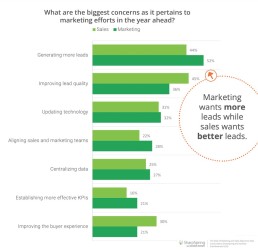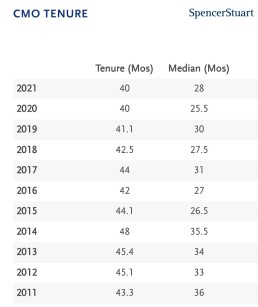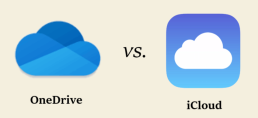The B2B Marketing-Sales Divide: More Leads vs. Better Leads
B2B marketers say their biggest marketing concern is how to generate more leads, whereas B2B salespeople say their biggest marketing concern is how to improve lead quality, according to recent research from SharpSpring and Ascend2.
The report was based on data from a survey conducted in February 2022 among 329 marketing and sales professionals who work for B2B firms.
Although both B2B marketers and salespeople cite lead quantity and quality as their biggest concerns pertaining to their firm's marketing efforts in the year ahead, marketers rank generating more leads as their top concern (52% of marketers cite) whereas salespeople rank improving lead quality as their top concern (45% of salespeople cite).

Both B2B marketers and salespeople say that moving leads from education to sales readiness is the buyer experience area most affected by misalignment between Marketing and Sales.
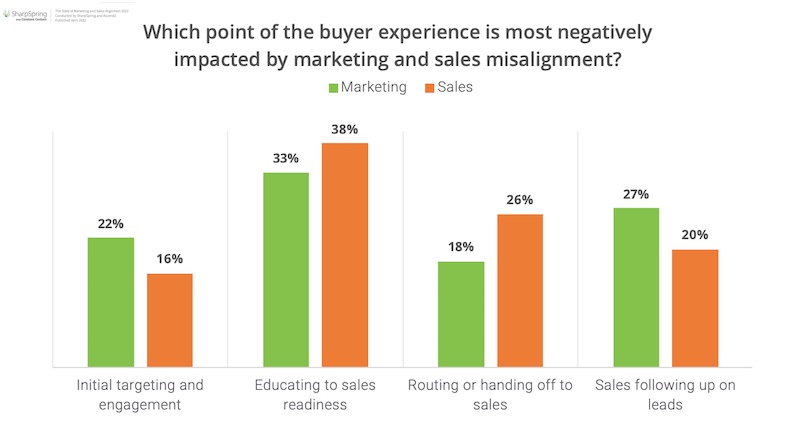
Respondents say the biggest benefits of Marketing and Sales alignment are higher conversions, increased revenue, and a more seamless customer experience.
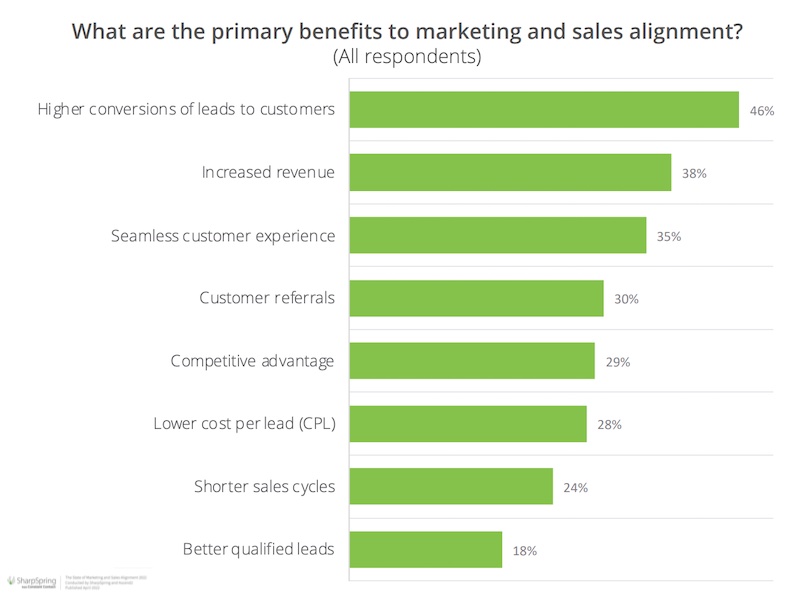
About the research: The report was based on data from a survey conducted in February 2022 among 329 marketing and sales professionals who work for B2B firms.
How To Use Price Transparency To Fight Trust Issues With B2B Buyers

The current bout of inflation is putting strain on purchasing power, and B2B e-commerce is no exception. E-commerce sales slowed significantly in Q1, dropping 3.7% between January and March and causing ripples of worry among merchants. Fortunately, there’s a way through inflation-related challenges for these sellers: to prioritize transparency and fair prices as a means of building up B2B buyers’ trust. The more buyers understand price transparency and believe your business has fair pricing, the more likely they’ll be to purchase and remain brand loyal.
When considering inflation’s impact on e-commerce, it’s worth noting that inflation may have first inflated B2B e-commerce growth numbers before cutting them back. Last year alone, $22 billion worth of e-commerce sales growth came from inflation.
Still, while inflation may have bolstered e-commerce sales numbers initially, the fact that sales are now slowing as household purchasing power diminishes poses a concern for B2B merchants. We know trust is a major factor in determining where B2B buyers choose to do business. Inflation ups the ante even more on trust. With supply chain issues and rising prices happening as a result of inflation, B2B buyers have to place even more trust in their suppliers. Whether buyers connect with their suppliers through a specific sales rep or a digital channel, it’s critical they feel supported and know that they are in good hands.
Read the original article from ChiefExecutive.net
Are we running into a freight recession?

There is substantial debate today regarding whether the trucking sector is heading into a freight recession. Or, could it be a that the decline in dry van and refrigerated spot prices is a function of more attractive contract prices coupled with freight patterns returning to their pre-COVID mix. That’s especially as year-over-year growth in inflation-adjusted retail trade sales slow and manufacturing picks back up. In this article, we look at the available data from government sources and the Logistics Managers Index (LMI) to try and shed some light on this issue.
To paraphrase Mark Twain: rumors of the death of the freight market have been greatly overstated. The data suggest that there has not been a substantial decline in trucking freight volumes in April and May. Rather, the market is returning towards a new equilibrium after having been profoundly discombobulated since the onset of the pandemic.
Our first piece of evidence comes from the Federal Reserve Board’s industrial production index for manufacturing excluding hi-tech products. We exclude hi-tech products because they contribute minimally to freight movements yet their upward movement tends to positively shift industrial production data. These data measure real output, meaning quantity of products produced in the USA (e.g., they are not affected by inflation).
The seasonally adjusted reading for April 2022 was the second highest reading since the end of the Great Recession, trailing only July 2014.
Read the original article from SCMR
The Average CMO Tenure at Major Brands
The average tenure of chief marketing officers at large US advertisers is only 3 years and 4 months, according to recent research from Spencer Stuart.
The annual report was based on an analysis of the tenures and backgrounds of CMOs at 100 of the most advertised US brands as of December 31, 2021.
The researchers found the average CMO tenure in 2021 was 40 months, tying 2020 as the lowest level in more than a decade, and the median tenure was 28 months.
The average CEO tenure in 2021 was 85 months, more than double the average CMO tenure.
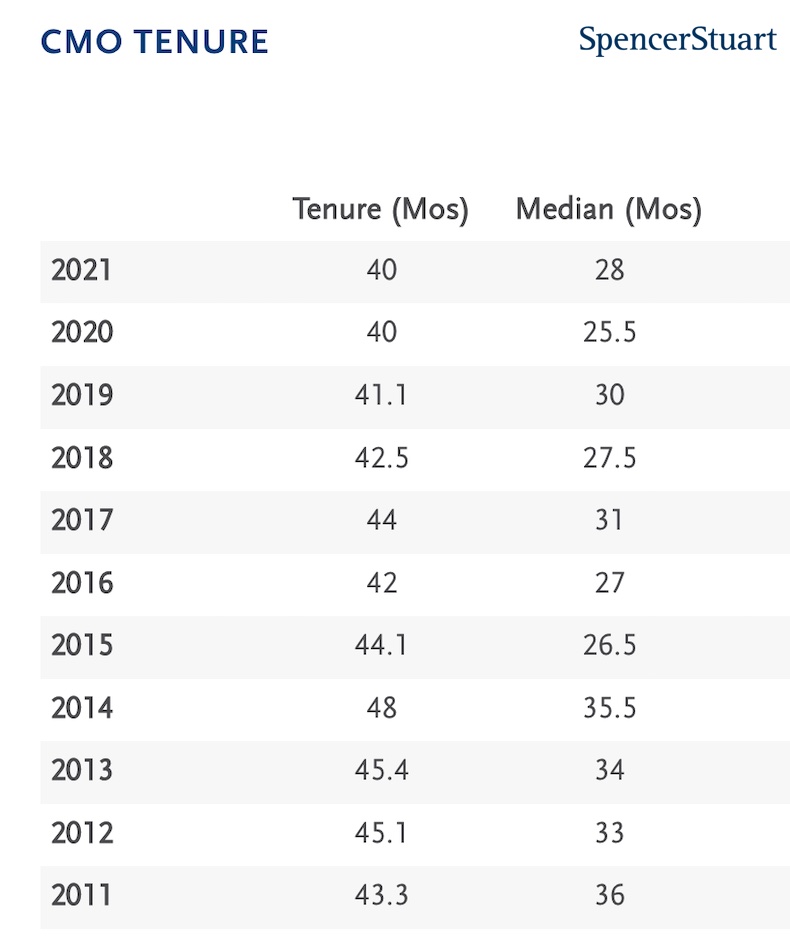
For the first time in the study's history, women outnumbered men in the CMO role (51% of CMOs at major US advertisers were women in 2021). That shift was driven by the fact that 71% of incoming CMOs at the brands examined were women in 2021.

Only 15% of CMOs in 2021 were from traditionally underrepresented racial or ethnic groups, a slight increase from 13% in 2020.
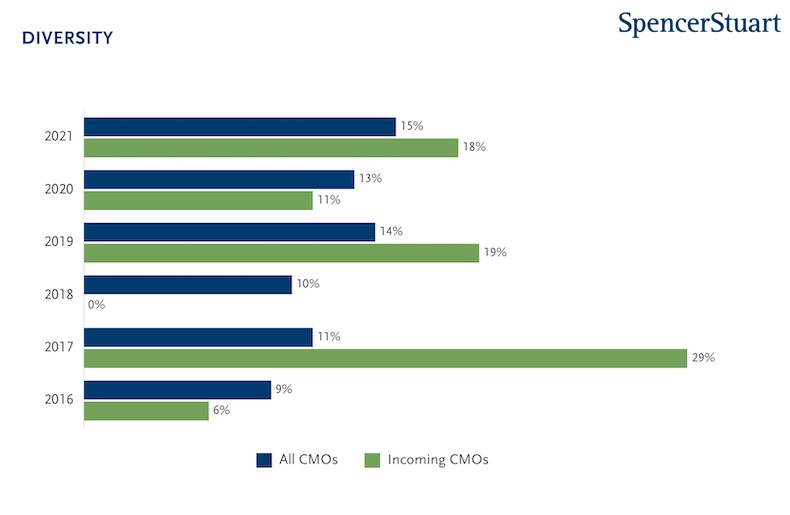
About the research: The annual report was based on an analysis of the tenures and backgrounds of CMOs at 100 of the most advertised US brands as of December 31, 2021.
CFOs should use AI to navigate 'dark horizons' in scenario planning: Gartner

CFOs in recent decades have faced several actual or possible nightmare scenarios — the collapse of mortgage finance, a once-in-a-century global pandemic, a sudden worldwide shortage of life-sustaining grains and the risk of the first nuclear weapons attack since 1945.
Most CFOs did not, or would not, predict such crises and the harm to their companies’ revenue and operations, according to Gartner. But by using artificial intelligence (AI) in scenario planning soon after a crisis erupts, a CFO can quickly estimate the business impact and act to limit losses.
“We’re not making a magical prediction about dark horizons,” Mark McDonald, a Gartner senior director analyst, said Monday in an interview. Instead, a CFO using AI can “navigate that horizon.”
By using AI in scenario planning, CFOs can evaluate a much broader range of possible risks and business outcomes and gain greater insights on the probability of occurrence and when and how to respond, McDonald said at the Gartner CFO and Finance Executive Conference.
“AI introduces a very compelling alternative to our traditional scenario planning process,” McDonald said during a presentation at the conference at National Harbor, Maryland. “It’s not going to eliminate your worst case scenario, but it’s maybe going to mitigate a worst-case scenario.”
CFOs tend to shy from gathering a broad range of data when attempting to limit risk through traditional scenario planning, McDonald said. “We’re averse to it in finance because it drives up the complexity and we’ve got to analyze all this new stuff.”
Read the original article from CFO DIve
Why four-day working week is 'doomed to fail'

The four-day work week was something of an HR musing just two years ago. Now, since the chaos and disruption of the pandemic, it seems zany new ways of working are all the rage. 4 Day Week Global, a not-for-profit community established by Andrew Barnes and Charlotte Lockhart, advocates the reduced working week, encouraging businesses to give the strategy a trial run. And while it’s receiving a lot of support from employers and employees, it’s still pretty divisive in HR circles.
And, for Garcia at least, she’s convinced it’s doomed to fail.
“The four-day workweek will fail,” she told HRD. “At least for the modern-day worker who’s been really clear about requesting the flexibility to work hard and be successful in their personal lives. You can’t always get doctor appointments, school performances and that meditation class you’ve desperately needed on the same day each week.”
This preference for flexibility has always been there, however the pandemic turned this ‘nice to have’ into a necessity. Employees are actively leaving their current roles in search for more flexible ones, candidates are only looking for employers that allow total flexibility. In fact, a report from Gartner found that 59% of employees say they’d only consider a new position or job that allows them to work from a location of their choice.
Read the original article here
UK employees begin four-day work week pilot

"We will be working with over 3000 UK employees to bring the four-day week to their businesses!"
Dubbed as the "biggest ever trial of a four-day week in the world," over 70 companies signed up for the UK pilot programme, coming from over 30 industries.
Employees who are a part of the pilot programme will still receive 100% of their pay for 80% of their time, "in exchange for a commitment to maintain at least 100% productivity."
This means 32 hours a week for employees, without their salaries reduced, in hopes that it would benefit them, employers, the economy, the society, and the environment.
"The UK works longer hours than most of Europe. It is not making us more productive," said the 4 Day Week Global on its webpage. "It is making us stressed, over-worked, and burnt out. It is time for a 4 Day Week."
Can four-day workweek succeed in work-obsessed America

Building the Next-Generation Workplace
With this in mind and considering that these young cohorts are quickly becoming key business decision-makers as baby boomers edge toward retirement, it’s not inconceivable that flexible work schedules – including four-day workweeks – will become a reality. It’s already a reality for employees at Bolt, who, after a successful three-month trial, are now permanently adopting a four-day workweek. According to a post-pilot employee survey, 84% of the fintech unicorn’s employees said they have been more productive, and 86% said they have been more efficient with their time. Additionally, 84% saw an improvement in their work-life balance. Moreover, a spokesperson told Business Insider that job applications were up 30% compared with December.
It’s less likely that a shortened workweek will become mandated. Instead, organizations and the individuals who work for them will choose based on what is right for them and enter emotional contracts that are mutually beneficial. To some, like Bolt, this may be taking a three-day weekend. To others, it may be implementing some other kind of flexible work schedule where employees work the hours needed to deliver the right value and outcomes.
At the same time, enterprises need to uplevel their use of technology to succeed in achieving this agile and autonomous workplace. While every industry has undergone a digital transformation these past two years, studies highlight several inefficiencies jeopardizing productivity amongst employees.
Read the original article here
Apple iCloud vs. Microsoft OneDrive for Business
The availability of cloud storage brings a new level of convenience to your business. It has been increasingly popular over traditional storage, especially for business organizations when storing files, sharing files, and protecting sensitive data. You can access the data from multiple devices at a time.
With better cloud storage, you can ensure your data is safe and store huge amounts of data for your business. Although someone may track an iPhone without iCloud or break into your Microsoft OneDrive and you may face data loss. But, due to security features, it's relatively hard to crack both OneDrive and iCloud.
If you plan to get cloud storage for your business, Apple iCloud and Microsoft OneDrive are probably the two best options available on the market. This blog will share a detailed comparison; hence, you can choose your suitable or preferable cloud storage.
Apple iCloud vs. Microsoft OneDrive: Comparison
Both iCloud and OneDrive have a lot to offer to their user base. However, to illustrate the better option for you, let us have a detailed comparison between them,
iCloud vs. OneDrive: Features
Apple iCloud and Microsoft OneDrive provide numerous similar features. Cloud storage includes device backup with syncing feature; you can share data and files with custom-made links and scan documents with the cell phone app.
OneDrive works excellent with other Microsoft apps like Word, Excel, etc. With OneDrive, you share files, and multiple users can use a shared file and folder simultaneously. You can access, edit or even share your files and folders from any device if you are connected to a network.
Apple, too, has provided similar integration for Apple iWork apps. The apps are free to use for iOS devices, and users can use or work on a file at a time. However, Apple doesn't allow its users to access or edit the documents from the browser, unfortunately limiting your accessibility to editing on synced devices.
Another incredible feature of OneDrive is its outstanding version history tool. You can even revert your documents to previous versions from the last month. You can access all documents, including photos, videos, and PDFs.
On the other hand, with Apple iCloud, the iWork apps save version history, but there's no particular versioning feature. Microsoft OneDrive has many useful features making iCloud second-best among the two. OneDrive's incredible version history and better integration stand out from iCloud.
iCloud vs. OneDrive: Storage
Anyone with OneDrive or iCloud gets 5 GB of free storage. The free storage is provided to test out the services, features, and other options. However, the space is not enough for businesses or professionals.
You should get a subscription plan on both iCloud and OneDrive if you tend to store more data and files for your companies.Apple's pricing options are $0.99 for 50 Gb of storage for users per month, $2.99 for 200GB storage per month, and $9.99for 2TB storage per month.
However, Microsoft OneDrive's subscription plan is a bit complex. The subscription plan includes 100 GB of storage for $1.99 per month. You can also get Microsoft 365, which provides you with 1TB of storage, and you can access Microsoft apps with it.
The pricing is $6.99 per month or $69.9 per year. If you subscribe to the family plan, you will get 1TB of cloud storage for six users and Microsoft Office for $9.99 per month or $99.99 per year. Although, in terms of pricing, Apple iCloud is relatively economic.
iCloud vs. OneDrive: Security
Both iCloud and OneDrive provide two-factor authentication features to add a layer of security. It helps you protect your account, files, and other sensitive data.
However, Microsoft’s Drive provides one additional security feature, called Personal vault. You can double up your security with the help of face scanning, fingerprint sensors, or codes.
The data are encrypted using 128-bit AES/TLS, providing you with a higher level of protection. But, only the business subscription plan has an encryption at-rest feature. Microsoft OneDrive has the upper hand over Apple iCloud regarding security.
iCloud vs. OneDrive: Performance
You can access or upload files on iCloud or OneDrive via pc, cell phone, or browser. Both are very convenient with effective synchronization. Apple has 50 GB compared to One Drive in maximum file size.
But unless your business works on a very large file size, 50 GB is more than enough. Apple iCloud works excellent if your company uses Apple devices. The iCloud is integrated with Apple's Mac Finder.
Although, you will find difficulties if you are not using Apple devices. iCloud is relatively harder to work with Windows, and its web browser interface is also ordinary compared to other cloud storage apps.
One Drive, a Microsoft prodigy, works excellent on Windows devices, and it has well-developed apps and features for mobile and other gadgets and Mac and other Apple devices.
OneDrive synchronizes and operates smoothly once the set-up is completed. For business, OneDrive provides you effective performances for both Apple and Windows devices to iCloud, which functions well only on Apple Devices.
iCloud vs. OneDrive: Syncing speed
iCloud is not good enough when handling large files compared to other cloud storage. Employees might find it annoying in business if they look for a higher syncing speed.
On the other hand, Microsoft provides you with a higher syncing rate due to many servers worldwide. Moreover, OneDrive, with its block-level copying, can make the syncing of Microsoft Office 365 files speed higher on devices.
The syncing is created by copying the selected parts of Microsoft Office data that have changed rather than copying the whole file.
Conclusion
We have compared various aspects of both iCloud and OneDrive. Both cloud storage has pros and cons, and we believe this blog will make better choices considering the preferences and features that meet your demands.
However, our preference is Microsoft OneDrive because of its wide range of useful features and excellent web browsing interface. Also, the flexibility to work with a border range of devices and it's a better choice for small businesses and freelancers.
Besides, iCloud only integrates and functions well on iPhones, iPads, and Macs, even though the subscription plan of iCloud is ideal for Apple owners looking for higher storage.
Hoping to Grow Your Ad Agency? Support Growth Goals With Existing Customers
 In the best-run agencies, about 60% to 70% of new net revenue comes from existing clients. At the same time, however, these agencies often lose anywhere between 10% to 15% of their clients. Attrition is inevitable, and it’s frequently due to factors outside of an agency’s control (e.g., mergers, reorganizations).
In the best-run agencies, about 60% to 70% of new net revenue comes from existing clients. At the same time, however, these agencies often lose anywhere between 10% to 15% of their clients. Attrition is inevitable, and it’s frequently due to factors outside of an agency’s control (e.g., mergers, reorganizations).
So, when setting your growth goals for the year, you need to take both numbers (new revenue and attrition) into account. Unfortunately, it’s easy to forget them when you’re in the day-to-day weeds. And because account executives serve as intermediaries between your agency and client roster, business growth will often hinge on their efforts.
If you’ve got an account executive managing $400,000 of adjusted growth income and the growth goal is 10%, then that individual must add $40,000 to the book. It only stands to reason that 60% to 70% of that number will come from existing clients. This might not sound like much, but tight budgets can cause the account executive to come up short.
In light of this, it’s more important than ever for you to position your account executives for success. Their wins are your wins, after all. Here are five ideas to help you support them in their business growth goals with existing customers:
Read the original article from ChiefExecutive.net
